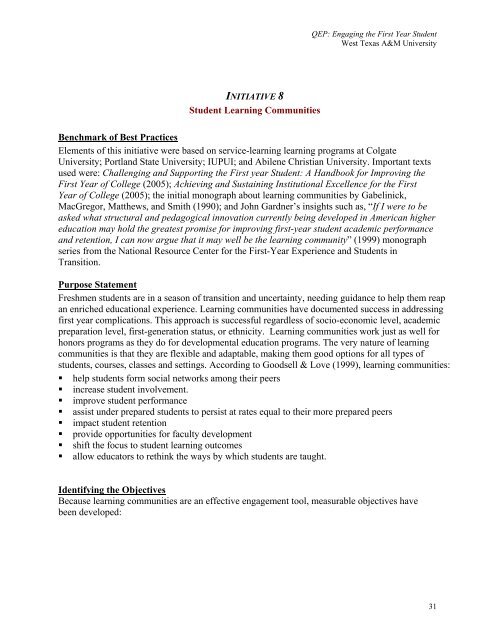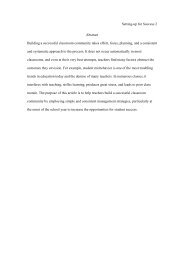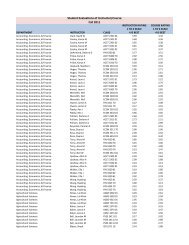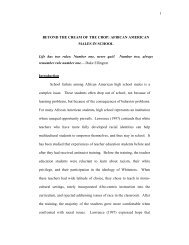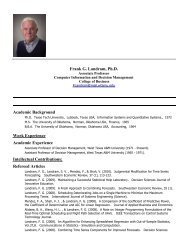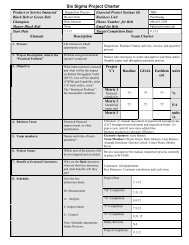(QEP) Engaging the First Year Student - West Texas A&M University
(QEP) Engaging the First Year Student - West Texas A&M University
(QEP) Engaging the First Year Student - West Texas A&M University
Create successful ePaper yourself
Turn your PDF publications into a flip-book with our unique Google optimized e-Paper software.
<strong>QEP</strong>: <strong>Engaging</strong> <strong>the</strong> <strong>First</strong> <strong>Year</strong> <strong>Student</strong><strong>West</strong> <strong>Texas</strong> A&M <strong>University</strong>INITIATIVE 8<strong>Student</strong> Learning CommunitiesBenchmark of Best PracticesElements of this initiative were based on service-learning learning programs at Colgate<strong>University</strong>; Portland State <strong>University</strong>; IUPUI; and Abilene Christian <strong>University</strong>. Important textsused were: Challenging and Supporting <strong>the</strong> <strong>First</strong> year <strong>Student</strong>: A Handbook for Improving <strong>the</strong><strong>First</strong> <strong>Year</strong> of College (2005); Achieving and Sustaining Institutional Excellence for <strong>the</strong> <strong>First</strong><strong>Year</strong> of College (2005); <strong>the</strong> initial monograph about learning communities by Gabelinick,MacGregor, Mat<strong>the</strong>ws, and Smith (1990); and John Gardner’s insights such as, “If I were to beasked what structural and pedagogical innovation currently being developed in American highereducation may hold <strong>the</strong> greatest promise for improving first-year student academic performanceand retention, I can now argue that it may well be <strong>the</strong> learning community” (1999) monographseries from <strong>the</strong> National Resource Center for <strong>the</strong> <strong>First</strong>-<strong>Year</strong> Experience and <strong>Student</strong>s inTransition.Purpose StatementFreshmen students are in a season of transition and uncertainty, needing guidance to help <strong>the</strong>m reapan enriched educational experience. Learning communities have documented success in addressingfirst year complications. This approach is successful regardless of socio-economic level, academicpreparation level, first-generation status, or ethnicity. Learning communities work just as well forhonors programs as <strong>the</strong>y do for developmental education programs. The very nature of learningcommunities is that <strong>the</strong>y are flexible and adaptable, making <strong>the</strong>m good options for all types ofstudents, courses, classes and settings. According to Goodsell & Love (1999), learning communities:• help students form social networks among <strong>the</strong>ir peers• increase student involvement.• improve student performance• assist under prepared students to persist at rates equal to <strong>the</strong>ir more prepared peers• impact student retention• provide opportunities for faculty development• shift <strong>the</strong> focus to student learning outcomes• allow educators to rethink <strong>the</strong> ways by which students are taught.Identifying <strong>the</strong> ObjectivesBecause learning communities are an effective engagement tool, measurable objectives havebeen developed:31


